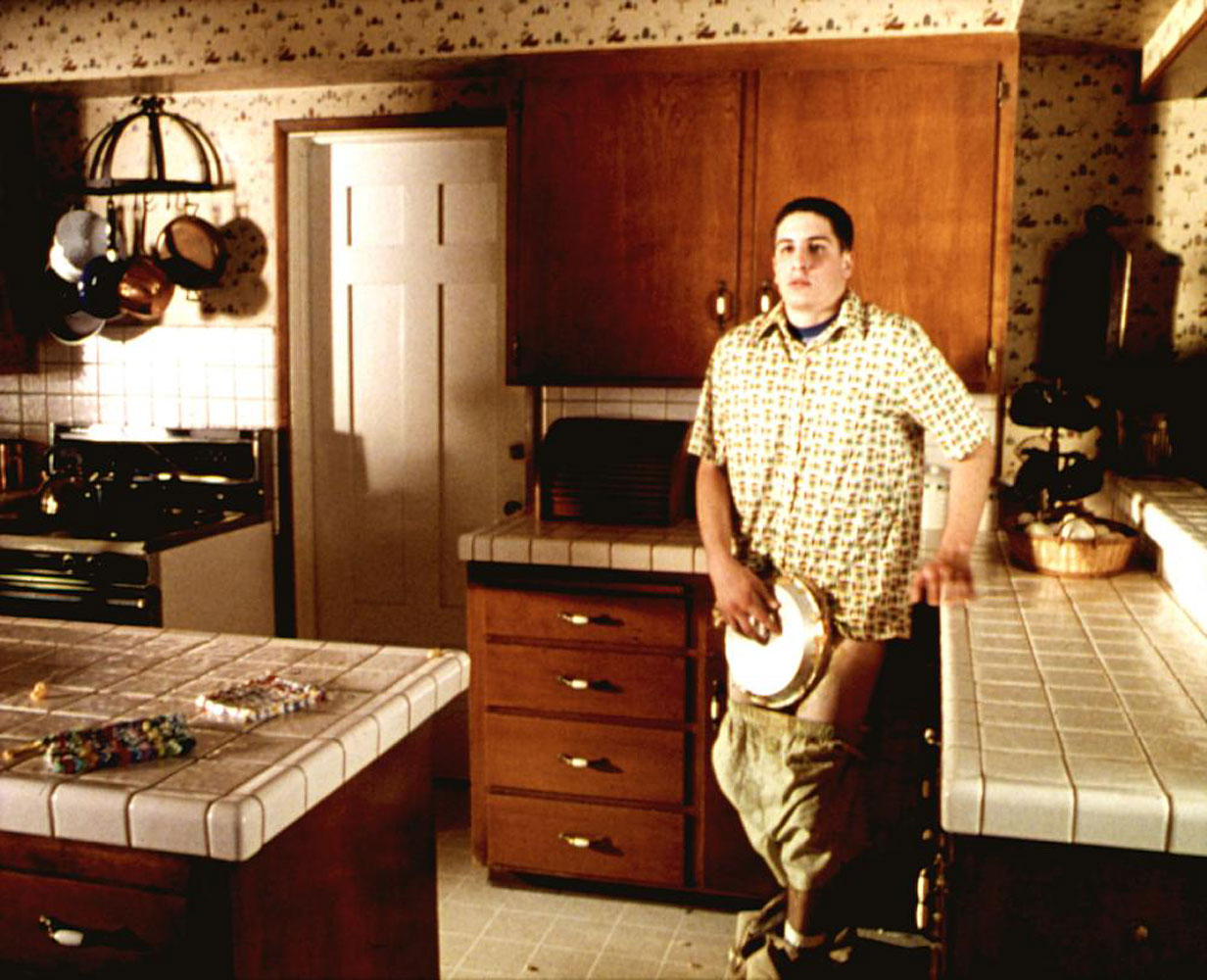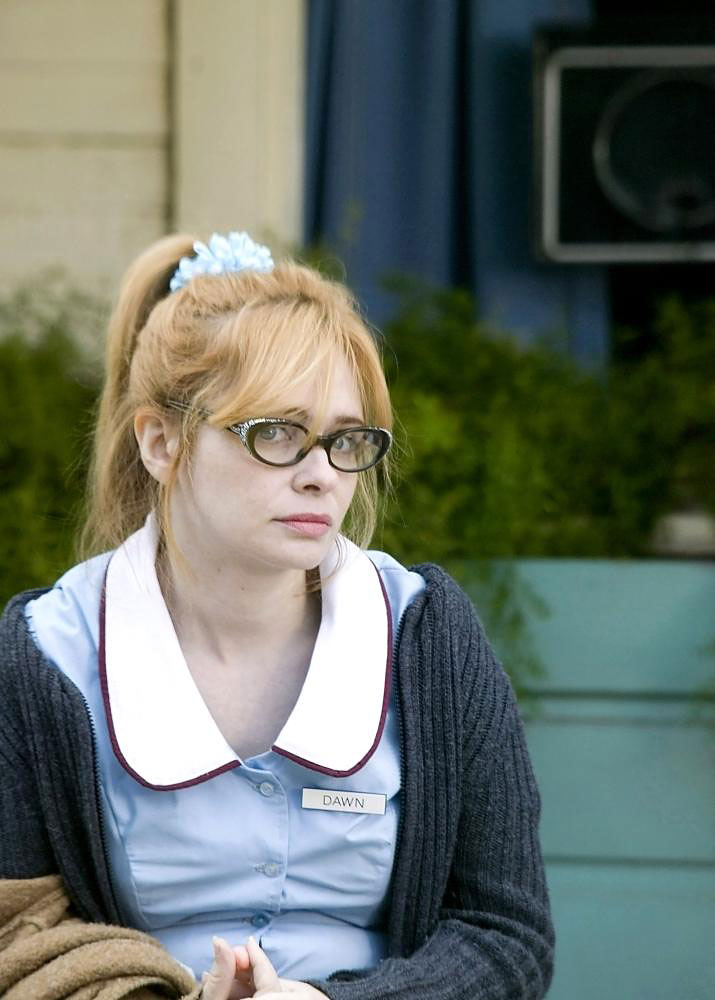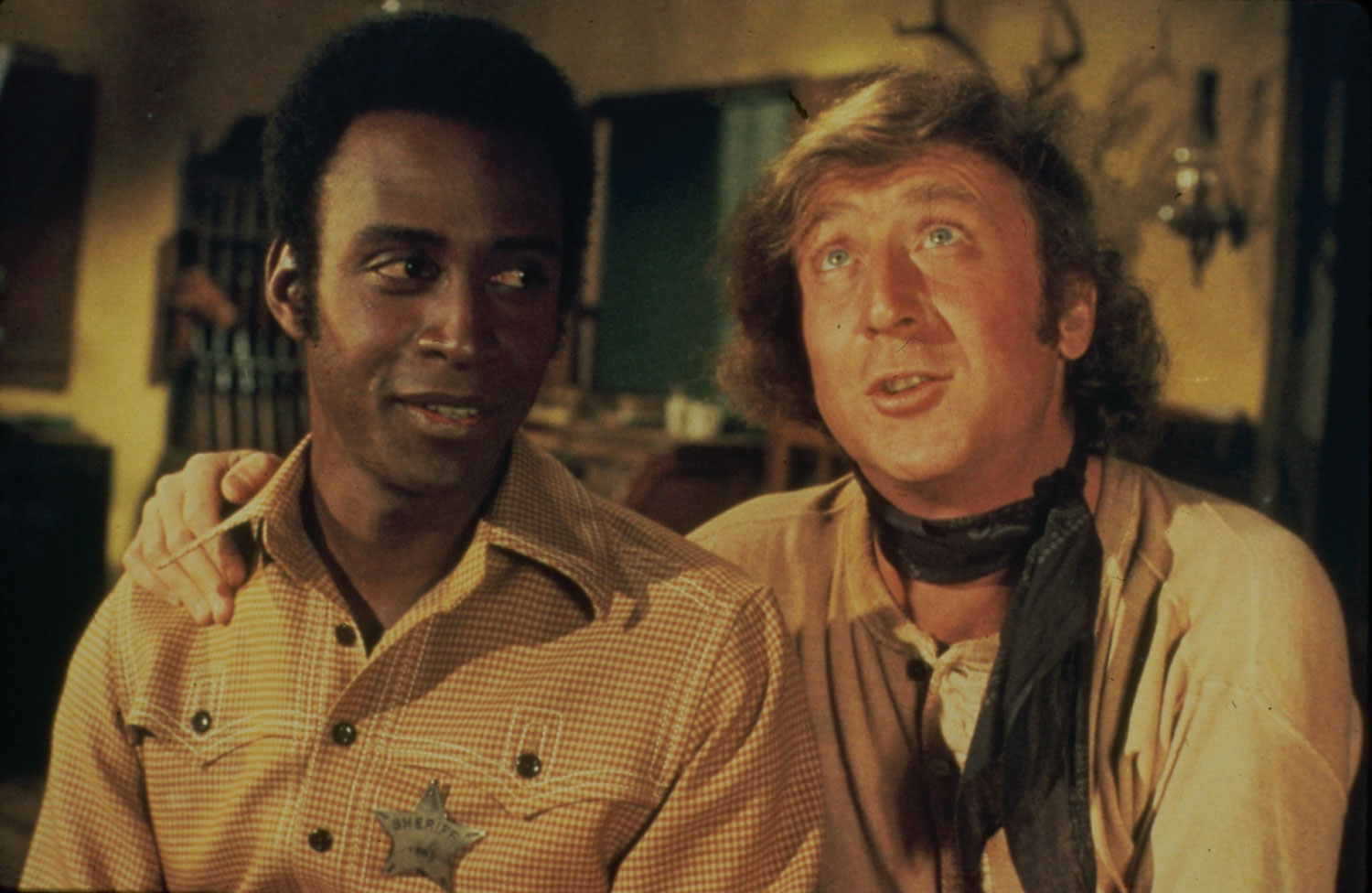Upper Crust
We used to think that there were so many pie scenes in movies because the dessert is so evocative: home and hearth, family holidays, and late-night comfort — even at a lonely roadside diner. But now, we think it’s probably just because pie is so deliciously messy.
Take, for instance, the already much-discussed pie-baking scene in the new movie Labor Day, where Josh Brolin’s demonstration to Kate Winslet of how to make a delicious peach pie serves as the same kind of gooey-yet-artisanal foreplay as the pottery-wheel scene in Ghost. To prepare for the scene, Labor Day novelist Joyce Maynard (who put her family recipe into the book) and former Martha Stewart food stylist Susan Spungen came to the set as consultants, and Brolin baked countless pies as rehearsal.
Of course, the flip side of baking a pie is destroying it – especially in the movies. That perfect crust gets pierced, filling and crumbs are mashed together — or, sometimes, the whole pie just gets thrown into someone’s face. If movie pies mean love and warmth, they also mean gluttony and humiliation.
Here, then, are 10 movies that made us reconsider what pie is really all about.
American Pie

The most notorious pie scene ever comes in this 1999 teen sex comedy that raised the bar (or lowered it, maybe) for gross-outs and embarrassment for the sake of laughs. Actually, the movie’s overarching joke – and it’s a film that grasped this before most – is that, in the Internet era, there’s no longer any expectation of privacy, so you shouldn’t expect your most shameful sexual secrets to remain secret for long.
This holds true repeatedly for the virginal Jim (Jason Biggs). Told that a woman’s genitals feel like warm apple pie, Jim spies his mom’s freshly-baked pastry cooling in the kitchen and does to the pie what Alexander Portnoy once did to a piece of liver, only to be caught in the act by his dad (Eugene Levy). Hard to tell who should be more embarrassed: Jim? Or Biggs, who will forever be known as the actor who humped a pie?
Waitress

Here’s a whole movie about pies — ones that are lovingly constructed by Southern diner waitress Jenna (Keri Russell). In her expert, flour-dusted hands, each pie is a masterpiece, and each has a meaning, related to whatever Jenna was feeling at the time she baked it. Some of her custard- or fruit-filled desserts are happy pies, but many are miserable, since Jenna is a virtual prisoner of her Neanderthal husband, Earl (Jeremy Sisto). He’s wary when she becomes pregnant, but outright livid when she wants to enter a pie bake-off with a cash jackpot, since he fears (justifiably, it turns out),that both the baby and the contest will distance his wife from him.
In fact, Jenna has an affair with her OB/GYN (Nathan Fillion), an illicit bond cemented with gifts of pie. Still, for all the movie’s ominous atmosphere and romance-gone-wrong, it’s actually a very sweet film — one that ends with a pie-themed lullaby, and with all the characters getting their just desserts.
Shane

Alan Ladd’s reluctant gunslinger hero is a man of few words, but then, so much of Shane is about things that must go unsaid. After all, the title character’s arrival at the Starrett farm threatens to displace paterfamilias Joe (Van Heflin), both as the father figure most admired by little Joey Starrett (Brandon de Wilde) and in the affections of Joe’s wife, Marian (Jean Arthur).
Shane and Marian are both too decent to act on their mutual attraction or even acknowledge it in words, but Joe seems to recognize that something is up when, with Shane as their dinner guest, Marian serves up the most delectable-looking apple pie in movie history, on the good china, with extra dessert forks. Soon, the pie-fueled Shane and Joe are trying to out-macho each other by chopping away at an old tree stump Joe has been unable to uproot by himself. The two men dig into it the way they dug into the pie, politely but ravenously, while a flushed Marian looks on.
Stand By Me

We know at the beginning of Stand By Me that Gordie (Wil Wheaton) is destined to grow up to be a writer. In fact, it seems like he’s going to become Stephen King (who wrote “The Body,” the story that is the movie’s source), judging by the grotesque campfire story Gordie tells his pals. There are no ghosts or ghouls, but the story of “Lardass” Hogan is a cautionary revenge tale of a bullied youngster with a disgusting denouement worthy of King’s Carrie.
In Gordie’s story, the harassed fat kid wreaks vengeance on his community at the local pie-eating contest. Before the blueberry feast, he swallows a bottle of castor oil and a raw egg. After stuffing his face with pie, Davey projectile vomits a blue gusher over the crowd, prompting a chain reaction of vomiting, or what Gordie calls “a complete and total barf-o-rama.” Gordie’s audience of 12-year-old boys is enraptured, but if you’re a grown-up watching the movie at home, you might feel inclined to fast-forward past this part.
Blazing Saddles

Not only does the climax of Mel Brooks’ classic Western spoof Blazing Saddles break through the fourth wall, it hurls a fusillade of pies through it. The movie’s final brawl between the good townsfolk of Rock Ridge and the desperadoes hired to drive them from their homes spills over onto an adjoining soundstage at the Warner Bros. studio lot, bursting through the set where a musical is being filmed. Once the gang of chorus boys has joined the melee, the fight moves to the studio commissary, where a pie fight is announced, and the entire cast gets creamed (including a group of hapless visitors on a studio tour).
Chief villain Hedy Hedley Lamarr (Harvey Korman) ducks into the men’s room, but not even he can stay dapper and fastidious for long; when he reappears, he’s been pied, too. It’s not the biggest pie fight in screen history, but it’s one of the funniest — and probably the most famous.
Sweeney Todd
The foulest pies on film are surely those baked up in Tim Burton’s gory adaptation of Stephen Sondheim’s musical satire on capitalism. Vengeful 19th-century London barber Sweeney Todd (Johnny Depp) gets the rich and powerful to climb to his second-story salon and bare their necks to his razors. The bodies go through a trap door, down a chute, and into the basement, where they become fodder for Mrs. Lovett’s (Helena Bonham Carter) savory meat pie shop on the ground floor. (When she boasts in song that she offers “the worst pies in London,” she’s not kidding.)
Soon, her business is booming — and so is his, despite the lack of repeat customers. Still, there seems to be an endless supply of hateful aristocrats and corrupt bureaucrats. So many, in fact, that you find yourself perversely rooting for Sweeney and Mrs. Lovett to keep cranking out the pasties.
The Help
Further proof that revenge is a dish best served in a pie tin comes in The Help, where housemaid Minny Jackson (Oscar-winning Octavia Spencer) comes up with a recipe for poetic justice after Hilly (Bryce Dallas Howard) fires her for daring to use the white folks’ toilet. In an apparent good will gesture, Minny bakes Hilly a chocolate pie and serves her a couple of helpings – then reveals to her that not all the brown filling in the pie is chocolate.
The incident comes back to haunt Hilly at a charity raffle where she wins one of Minny’s chocolate pies (a real one) and assumes she’s being insulted. Fortunately for Minny, Hilly can’t retaliate against her without making public her own humiliation. Minny refers to her poo-filled pastry as “the Terrible Awful,” but she could also have called it Humble Pie.
Dr. Strangelove
Stanley Kubrick wanted to end his 1964 satire of nuclear doomsday in a very specific way: a pie fight between Russian and American officials in the War Room beneath Washington where the President (Peter Sellers), adviser Dr. Strangelove (also Sellers), General Buck Turgidson (George C. Scott) and other officials have tried and failed to prevent the rogue missile launch. But Kubrick felt the filmed result wrecked the tone of the movie, taking it from dry ironic absurdity to slapstick silliness. Plus, Turgidson had a line about the young president being struck down in the prime of his life by a pie; in the months following the JFK assassination, that line suddenly seemed in bad taste.
Kubrick cut the film so that it would end with Strangelove miraculously rising from his wheelchair (“Mein Fuhrer! I can walk!”, followed by a montage of mushroom clouds. The footage of the pie fight seems to have been lost, but still photos remain, giving a good idea of the gooey chaos that, even in a movie whose punchline was the destruction of the world, was just too over-the-top. (You can see the stills in the behind-the-scenes documentary embedded on this page, starting at about 35:30.)
The Great Race
Inspired by the epic pie fight staged by Laurel and Hardy in their short “Battle of the Century,” director Blake Edwards decided to throw the biggest pie fight of all time in The Great Race. The comedy about a cross-continental early 20th-century auto race between daredevils The Great Leslie (Tony Curtis) and Professor Fate (Jack Lemmon) takes a detour in a European kingdom called Carpania, where the rivalry blunders into a vast bakery.
According to Hollywood lore, the ensuing battle involved some 2,500 pies made with real fruit and custard, and it took three days to shoot. It runs for a good five minutes on screen, with Curtis remaining miraculously immaculate long after the rest of the cast looks like walking Jackson Pollock paintings. (Finally, Natalie Wood lands a good solid hit to Curtis’ face.) It may not be the funniest pie fight ever, but it’s surely the grandest.
Heartburn
Nora Ephron made some witty movies about cooking (Julie & Julia) and love (Sleepless in Seattle), but food and love didn’t always go together harmoniously in her films. Think of Meg Ryan irking Billy Crystal with her persnickety salad and pie order (or embarrassing him with her fake orgasm in the deli, for that matter) in When Harry Met Sally, or Ryan scolding a gluttonous Tom Hanks for eating the party tray garnish in You’ve Got Mail, or Ryan and her sisters having a flour fight while trying to cook Thanksgiving dinner in Hanging Up. But nowhere is the food-love connection messier than in Ephron’s screenplay for Heartburn, based on her autobiographical novel about her marriage to Carl Bernstein.
In the Mike Nichols-directed film, the Ephron character, food writer Rachel (Meryl Streep) spends a lot of time enchanting the Bernstein character, political columnist Mark (Jack Nicholson), with her repertoire of recipes. Yet neither her cooking prowess nor even her pregnancy is enough to keep him from straying. In the movie’s climax, at a dinner party, she’s confronted with his latest betrayal. She walks to the kitchen counter, returns with a cream pie, thrusts it in his face, calmly asks him for the car keys and drives out of his life forever.
More Must-Reads from TIME
- Cybersecurity Experts Are Sounding the Alarm on DOGE
- Meet the 2025 Women of the Year
- The Harsh Truth About Disability Inclusion
- Why Do More Young Adults Have Cancer?
- Colman Domingo Leads With Radical Love
- How to Get Better at Doing Things Alone
- Michelle Zauner Stares Down the Darkness
Contact us at letters@time.com